By Chandra Bhushan, CEO, iFOREST
On September 2, Bhubaneswar became the first Indian city to release an Integrated Heat and Cooling Action Plan (IHCAP) to comprehensively tackle two growing crises—rising heat stress and the explosion in air conditioning demand.
Heat stress is not new to India. Over the past two decades, the country has experienced increasingly frequent and intense heatwaves that have claimed thousands of lives, reduced worker productivity, and strained health systems. But the crisis has changed. Cities are now caught in a vicious cycle of heat and cooling—higher temperatures and humidity drive up air-conditioning use, which worsens the urban heat island (UHI) effect and greenhouse gas emissions. This, in turn, makes cities even hotter—and more dependent on cooling.
It is precisely this cycle that Bhubaneswar’s IHCAP seeks to break. It is India’s first city-level plan that integrates urban planning, green buildings, sustainable cooling, and heat adaptation measures under one umbrella.
A city on the frontline of heat
Bhubaneswar has long been one of India’s most heat-affected cities. Over the last four decades, average temperatures and humidity levels have risen steadily across the year. Even more worrying is the rise in night-time temperatures, which robs people of relief and increases health risks. Today, heat stress stretches from February to October. According to the India Meteorological Department’s (IMD) “feels like” index, which uses temperature and humidity to measure heat stress, the city endured nearly 230 days of yellow or orange heat alerts in 2024.
Rapid urbanisation has further compounded heat stress. Between 2018 and 2024, Bhubaneswar’s built-up area grew by 23%, while vegetation declined by nearly 10% and water bodies by a staggering 75%. The result is a far more pronounced UHI effect, with the city now 2 to 5°C hotter than surrounding rural areas.
The impacts are already evident. Outdoor workers—from construction crews to street vendors—lose 20-30% of productivity and wages to heat stress. Overall, the city lost 8.6% of its annual income due to heat stress. At the same time, AC ownership has more than doubled in just two years, rising from 6% of households in 2021 to 15% in 2023. Cooling now accounts for one-third of the city’s electricity use—and nearly two-thirds in the peak summer months.
Looking ahead, the situation could worsen dramatically. Under an intermediate climate warming scenario, a “normal hot day” in 2050 will feel like today’s extreme heat days. The city, therefore, will have to rely on cooling to survive. Under a business-as-usual (BAU) scenario, therefore, electricity demand from cooling could rise 7.6 times by 2050 compared to current levels.
What the IHCAP offers
Against this backdrop, Bhubaneswar’s IHCAP lays out a comprehensive five-pillar strategy:
Cool the city: Expand greenery, revive water bodies, promote cool roofs, and redesign streets to reduce UHI.
Cool buildings: Implement energy conservation building codes and promote climate-responsive designs to reduce heat absorption and enhance indoor comfort.
Sustainable cooling for all: Ensure access to affordable, efficient, and climate-friendly cooling solutions such as efficient fans and ACs, district cooling systems, and white roofs for low-income homes.
Enhance heat resilience: Strengthen electricity, water, and health systems; build cooling shelters and provide cool bus stops and public water kiosks.
Adapt to heat: Update heat alert thresholds to account for humidity and night-time temperatures, provide insurance to vulnerable workers, and expand awareness campaigns.
If implemented effectively, these interventions could reduce surface temperatures by 0.5-9.4°C, depending on the type of measure, and cut the city’s cooling-related electricity demand by 44-67% compared to the BAU scenario.
Beyond Bhubaneswar
The IHCAP connects two national policies that have so far worked in silos. The India Cooling Action Plan (ICAP) of the environment ministry promotes sustainable cooling and the Heat Action Plan (HAP) of the National Disaster Management Authority (NDMA) (focusses primarily on early warning and heat adaptation. By unifying them, the IHCAP offers a comprehensive framework to address heat stress that other cities can adapt and adopt.
Scaling this framework, however, will require significant policy reforms. The NDMA’s HAP guidelines must be updated to include heat mitigation and sustainable cooling measures. City master plans and building codes will also need revision. For example, the Energy Conservation and Sustainable Building Code, 2024, for commercial and institutional buildings and the Eco-Niwas Samhita 2024 for residential buildings cover only a fraction of upcoming construction. In Bhubaneswar, just 25% of commercial and institutional buildings and a mere 1.5% of residential construction fall under these codes. Likewise, master plans do not consider UHI, heat mitigation strategies, or the need for heat-resilient infrastructure.
By mid-century, India will be home to 600-700 million urban residents, most of them in heat-stressed cities. Without integrated action, we risk a future where outdoor work becomes unsafe for millions, inequality deepens, and cities completely rely on cooling appliances to survive.
Bhubaneswar’s IHCAP, however, shows that cities can avoid this dystopian future and break the vicious cycle of heat and cooling through scientific modelling, innovative planning, and forward-looking policy.

